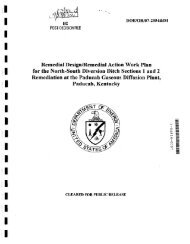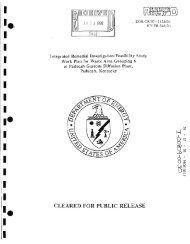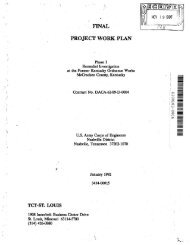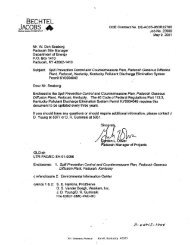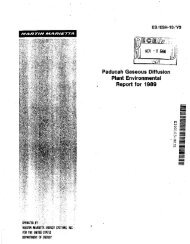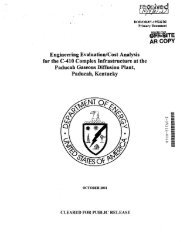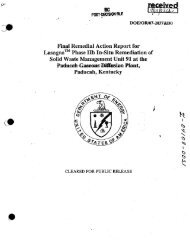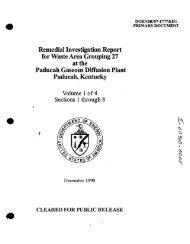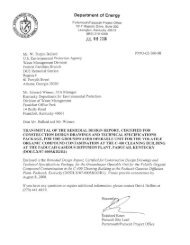1 - paducah environmental information center
1 - paducah environmental information center
1 - paducah environmental information center
You also want an ePaper? Increase the reach of your titles
YUMPU automatically turns print PDFs into web optimized ePapers that Google loves.
Paducah Site<br />
nucleus of· an excited atom. Gamma rays are<br />
indentical to X rays except for the source of the<br />
emission.<br />
GaUssian putT/plume model - A computersimulated<br />
atmospheric dispersion of a release<br />
using a Gaussian (normal) statistical distribution<br />
to determine concentrations .in air.<br />
grab sample - A sample collected instantaneously<br />
with a glass or plastic bottle placed below the<br />
water ·surface to collect surface water samples<br />
(also called dip samples).<br />
groundwater, unconfined. - Groundwater<br />
exposed to the unsaturated zone.<br />
half-life, radiological - The time required for<br />
half of a given. number of .atoms of. a specific<br />
radionuclide to decay. E~ch nuclide has a unique<br />
half-life.<br />
'<br />
ion - An atom or compound that carries an<br />
electrical charge.<br />
irradiation - Exposure to radiation.<br />
isotopes - Forms of an element having the same<br />
number of protons but differing numbers of<br />
neutrons in their nuclei.<br />
• long-lived isotope - A radionuclide that<br />
decays at such a slow rate that a quantity<br />
of it will exist for an extended period<br />
(half-life is greater than three years).<br />
• short-lived isotope - A radionuclide that<br />
decays so rapidly that a given quantity is<br />
transformed almost· completely into<br />
decay products within a short period<br />
(half-life is two days or less).<br />
hydrogeology - Hydraulip aspects of site<br />
geology.<br />
J;tydrology - The science dealing with the<br />
properties, distribution, and circulation of<br />
natural water syst~ms.'<br />
in situ - In its original plllce; field measurements<br />
taken without removing the sample froni its origin;<br />
remediation performed while groundwater<br />
remains belmy the surface.<br />
internal dose factor - A factor used to convert<br />
intakes' of raruonuc~des to dose equivalents.<br />
internal radiation - Occurs when natural<br />
radionuclides enter the body, by ingestion of foods,<br />
milk, or water or by inhalation. Radon is the major<br />
contributor to the annual dose equivalent for<br />
internal radionuclides.<br />
lower limit of detection - The smallest<br />
concentration or amount of analyte that can be<br />
reliably detected in a sample at a 95% confidence<br />
level.<br />
maximally exposed individual - A hypothetical<br />
individual who remains in an uncontrolled area and<br />
would, when all potential routes of exposure from<br />
a facility'S operations are considered, receive the<br />
greatest possible dose equivalent.<br />
migration - The transfer or movement of a<br />
material through air, soil, or groundwater.<br />
milliroentgen (mR) - A measure of X-ray or<br />
gamma radiation. The unit is one-thousandth of a<br />
roentgen.<br />
minimum detectable concentration - The<br />
smallest amount or concentration of a radionuclide<br />
that can be distinguished in a sample by a given<br />
G-4<br />
Glossary



